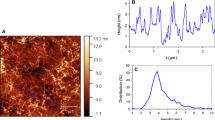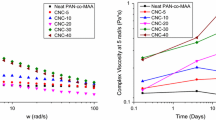Abstract
Nanofibrillated cellulose (NFC) was compounded with poly(acrylic acid) (PAA) via solvent casting. Nanocomposite films were thermally-crosslinked to allow the formation of ester bonds between NFC and PAA, as confirmed by 13CNMR and infrared spectroscopy. The network morphology of the cellulose nanofibrils was left intact by the introduction of PAA and crosslinking. Water absorption and swelling was diminished by the introduction of crosslinking, due to the reduced number of vacant hydroxyl and carboxyl groups available to interact with water molecules. Crosslinking with PAA increased the activation energy required for thermal degradation. PAA effectively reinforced NFC, increasing Young’s modulus, tensile strength and glass transition temperature. Crosslinking imparted restraints on segmental motion of polymer chains, further enhancing the thermomechanical properties and retaining elasticity. Wet-strength properties were enhanced due to the reduced hydrophilicity of crosslinked nanocomposite films.








Similar content being viewed by others
References
Al-Turaif HA (2013) Relationship between tensile properties and film formation kinetics of epoxy resin reinforced with nanofibrillated cellulose. Prog Org Coat 76:477
Area MC, Cheradame H (2011) Paper aging and degradation: recent findings and research methods. Bioresources 6:5307–5337
Baştürk E, Demir S, Daniş Ö, Kahraman MV (2013) Covalent immobilization of α-amylase onto thermally crosslinked electrospun PVA/PAA nanofibrous hybrid membranes. J Appl Polym Sci 127:349–355
Cho M, Park B (2011) Tensile and thermal properties of nanocellulose-reinforced poly(vinyl alcohol) nanocomposites. J Indust Eng Chem 17:36–40
Chung H, Woo K, Lim S (2004) Glass transition and enthalpy relaxation of cross-linked corn starches. Carbohydr Polym 55:9–15
Clemons C, Sedlmair J, Illman B, Ibach R, Hirschmugl C (2013) Chemically imaging the effects of the addition of nanofibrillated cellulose on the distribution of poly(acrylic acid) in poly(vinyl alcohol). Polymer 54:2058–2061
Dubinsky S, Grader GS, Shter GE, Silverstein MS (2004) Thermal degradation of poly(acrylic acid) containing copper nitrate. Polym Degrad Stab 86:171–178
Dubolazov A, Nurkeeva Z, Mun G, Khutoryanskiy V (2006) Design of mucoadhesive polymeric films based on blends of poly(acrylic acid) and (hydroxypropyl) cellulose. Biomacromolecules 7:1637–1643
Dutta J (2012) Synthesis and characterization of γ-irradiated PVA/PEG/CaCl2 hydrogel for wound dressing. Amer J Chem 2:6–11
Endo R, Saito T, Isogai A (2013) TEMPO-oxidized cellulose nanofibril/poly(vinyl alcohol) composite drawn fibers. Polymer 54:935
Eyholzer C, Bordenau N, Lopez-Suevos F, Rentsch D, Zimmermann T, Oksman K (2010) Preparation and characterization of water-redispersible nanofibrillated cellulose in powder form. Cellulose 17:19–30
Fox DM, Lee J, Zammarano M, Katsoulis D, Eldred DV, Haverhals LM, Trulove PC, De Long HC, Gilman JW (2012) Char-forming behavior of nanofibrillated cellulose treated with glycidyl phenyl POSS. Carbohydr Polym 88:847–858
Fujisawa S, Ikeuchi T, Takeuchi M, Saito T, Isogai A (2012) Superior reinforcement effect of TEMPO-oxidized cellulose nanofibrils in polystyrene matrix: optical, thermal, and mechanical studies. Biomacromolecules 13:2188–2194
Gärdlund L, Wågberg L, Gernandt R (2003) Polyelectrolyte complexes for surface modification of wood fibres: II. Influence of complexes on wet and dry strength of paper. Colloids Surf Physicochem Eng Aspects 218:137–149
Gilardi G, Abis L, Cass AEG (1995) Carbon-13 CP/MAS solid-state NMR and FT-IR spectroscopy of wood cell wall biodegradation. Enzyme Microb Technol 17:268–275
Hubbe M (2006) Bonding between cellulosic fibers in the absence and presence of dry-strength agents—a review. Bioresources 1:281–318
Jafarpour G, Roig F, Dantras E, Boudet AM, Lacabanne C (2007) Influence of water on localized and delocalized molecular mobility of cellulose. J Non-Cryst Sol 3:4108–4115
Kennedy JE, Lyons JG, Geever LM, Higginbotham CL (2009) Synthesis and characterisation of styrene butadiene styrene-g-acrylic acid for potential use in biomedical applications. Mater Sci Eng, C 29:1655–1661
Kim DS, Park HB, Rhim JW, Lee YM (2005) Proton conductivity and methanol transport behavior of cross-linked PVA/PAA/silica hybrid membranes. Solid State Ionics 176:117–126
Klemm D, Kramer F, Moritz S, Lindström T, Ankerfors M, Gray D, Dorris A (2011) Nanocelluloses: a new family of nature-based materials. Angew Chem Inter Ed 50:5438–5466
Kondo T (1997) The assignment of IR absorption bands due to free hydroxyl groups in cellulose. Cellulose 4:281–292
Kondo T, Sawatari C (1996) A Fourier transform infra-red spectroscopic analysis of the character of hydrogen bonds in amorphous cellulose. Polymer 37:393–399
Kono H, Yunoki S, Shikano T, Fujiwara F, Erata T, Takai M (2002) CP/MAS 13C NMR study of cellulose and cellulose derivatives. 1. Complete assignment of the CP/MAS 13C NMR spectrum of the native cellulose. J Am Chem Soc 124:7506–7511
Kučerová I, Ohlídalová M, Novotná M, Michalcová A (2007) Examination of corroded wood by ammonium phosphate and sulphate-based fire retardants—the results of the prague castle roof timber examination ICOMOS IWC - XVI International Symposium, Florence, Venice and Vicenza, 11th–16th Nov 2007, pp 1–4
Kumeta K, Nagashima I, Matsui S, Mizoguchi K (2003) Crosslinking reaction of poly(vinyl alcohol) with poly(acrylic acid) (PAA) by heat treatment: effect of neutralization of PAA. J Appl Polym Sci 90:2420–2427
Lee S, Mohan DJ, Kang I, Doh G, Lee S, Han S (2009) Nanocellulose reinforced PVA composite films: effects of acid treatment and filler loading. Fiber Polym 10:77–82
Li L, Hsieh Y (2005) Ultra-fine polyelectrolyte hydrogel fibres from poly(acrylic acid)/poly(vinyl alcohol). Nanotechnology 16:2852
Littunen K, Hippi U, Saarinen T, Seppälä J (2013) Network formation of nanofibrillated cellulose in solution blended poly(methyl methacrylate) composites. Carbohydr Polym 91:183
Liu A, Walther A, Ikkala O, Belova L, Berglund LA (2011) Clay nanopaper with tough cellulose nanofiber matrix for fire retardancy and gas barrier functions. Biomacromolecules 12:633–641
Loría-Bastarrachea MI, Carrillo-Escalante HJ, Aguilar-Vega MJ (2002) Grafting of poly(acrylic acid) onto cellulosic microfibers and continuous cellulose filaments and characterization. J Appl Polym Sci 83:386–393
Lu P, Hsieh L (2009) Cellulose nanocrystal-filled poly(acrylic acid) nanocomposite fibrous membranes. Nanotechnology 20:415604
Luo H, Hu J, Zhu Y, Wu J, Zhang S, Fan Y, Ye G (2013) Mechanically adaptive cellulose-poly(acrylic acid) polymeric composites in wet/dry cycles. J Appl Polym Sci 127:675–681
Maeda S, Fujiwara Y, Sasaki C, Kunimoto Ko-Ki (2011) Structural analysis of microbial poly(ε- l -lysine)/poly(acrylic acid) complex by FT-IR, DSC, and solid-state 13C and 15N NMR. Polym J 44:200–203
McNeill IC, Sadeghi SMT (1990) Thermal stability and degradation mechanisms of poly(acrylic acid) and its salts: part 1—poly(acrylic acid). Polym Degrad Stab 29:233–246
Moon RJ, Martini A, Nairn J, Simonsen J, Youngblood J (2011) Cellulose nanomaterials review: structure, properties and nanocomposites. Chem Soc Rev 40:3941–3994
Myllytie P, Salmén L, Haimi E, Laine J (2010) Viscoelasticity and water plasticization of polymer-cellulose composite films and paper sheets. Cellulose 17:375–385
Nakagaito AN, Yano H (2005) Novel high-strength biocomposites based on microfibrillated cellulose having nano-order-unit web-like network structure. Appl Phys A 80:155–159
Nikolaeva O, Budtova T, Alexeev V, Frenkel S (2000) Interpolymer complexation between polyacrylic acid and cellulose ethers: formation and properties. J Polym Sci, Part B: Polym Phys 38:1323–1330
Nogi M, Handa K, Nakagaito AN, Yano H (2005) Optically transparent bionanofiber composites with low sensitivity to refractive index of the polymer matrix. Appl Phys Lett 87:243110
Oh SY, Yoo DI, Shin Y, Seo G (2005) FTIR analysis of cellulose treated with sodium hydroxide and carbon dioxide. Carbohydr Res 340:417–428
Pahimanolis N, Salminen A, Penttilä PA, Korhonen JT, Johansson L, Ruokolainen J, Serimaa R, Seppälä J (2013) Nanofibrillated cellulose/carboxymethyl cellulose composite with improved wet strength. Cellulose 20:1459–1468
Paralikar SA, Simonsen J, Lombardi J (2008) Poly(vinyl alcohol)/cellulose nanocrystal barrier membranes. J Membr Sci 320:248–258
Peresin MS, Habibi Y, Vesterinen A, Rojas OJ, Pawlak JJ, Seppälä JV (2010) Effect of moisture on electrospun nanofiber composites of poly(vinyl alcohol) and cellulose nanocrystals. Biomacromolecules 11:2471–2477
Pourjavadi A, Soleyman R, Barajee GR (2008) Novel nanoporous superabsorbent hydrogel based on poly(acrylic acid) grafted onto salep: synthesis and swelling behavior. Starch–Stärke 60:467–475
Priest WJ (1951) Swelling of polyvinyl alcohol in water. J Polym Sci 6:699–710
Şakar-Deliormanli A (2012) Flow behavior of hydroxypropyl methyl cellulose/polyacrylic acid interpolymer complexes in aqueous media. Polym Int 61:1751–1757
Salmah H, Ismail H, Bakar AA (2008) The effects of dynamic vulcanization and compatibilizer on properties of paper sludge-filled polypropylene/ethylene propylene diene terpolymer composites. J Appl Polym Sci 107:2266–2273
Srithep Y, Turng L, Sabo R, Clemons C (2012) Nanofibrillated cellulose (NFC) reinforced polyvinyl alcohol (PVOH) nanocomposites: properties, solubility of carbon dioxide, and foaming. Cellulose 19:1209–1223
Swantomo D, Megasari K (2013) Synthesis of controlled release fertilizers based on smart biodegradable hydrogel cellulose-vinyl monomers using radiation. Indonesia Toray Science Foundation Seminar on Science and Technology Session, Vol. A, pp 1–9
Syverud K, Kirsebom H, Hajizadeh S, Chinga-Carrasco G (2011) Cross-linking cellulose nanofibrils for potential elastic cryo-structured gels. Nanoscale Res Lett 6:626
Trakulsujaritchok T, Hourston DJ (2006) Damping characteristics and mechanical properties of silica filled PUR/PEMA simultaneous interpenetrating polymer networks. Euro Polym J 42:2968–2976
Vasilescu AS, Ponta CC (1996) A 13C-NMR study of polyacrylic acid gels as radioactive ion sorbents. Prog Colloid Polym Sci 102:98–100
Zhou, Tashiro K, Hongo T, Shirataki H, Yamane C, Ii T (2001) Influence of water on structure and mechanical properties of regenerated cellulose studied by an organized combination of infrared spectra, X-ray diffraction, and dynamic viscoelastic data measured as functions of temperature and humidity. Macromolecules 34:1274–1280
Author information
Authors and Affiliations
Corresponding author
Rights and permissions
About this article
Cite this article
Spoljaric, S., Salminen, A., Luong, N.D. et al. Crosslinked nanofibrillated cellulose: poly(acrylic acid) nanocomposite films; enhanced mechanical performance in aqueous environments. Cellulose 20, 2991–3005 (2013). https://doi.org/10.1007/s10570-013-0061-x
Received:
Accepted:
Published:
Issue Date:
DOI: https://doi.org/10.1007/s10570-013-0061-x




